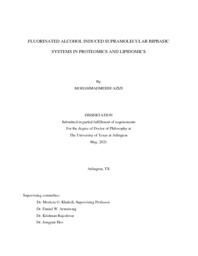| dc.description.abstract | The Fluoroalcohol induced Supramolecular Biphasic (FAiS-BP) systems are composed of a supramolecular phase which is a highly concentrated mixture of a fluoroalcohol and an amphiphile, and a separate aqueous-rich phase. The first part of this study presents new classes of FAiS-BP systems and studies their application in identification and coverage enhancement of low-abundance and/or hydrophobic proteins, such as integral membrane proteins. By taking the advantage of FAiS-BP systems in proteomics, we can concomitantly extract, fractionate, and enrich proteins; therefore, an additional separation dimension and a simple step of enrichment would be added prior to the LC-MS.
Yeast proteins (Saccharomyces cerevisiae yeast) were fractionated between the two phases of FAiS-BP systems and subjected to tryptic digestion and LC-MS/MS analysis. The results of FAiS-BP systems were compared to commonly used sample preparation techniques in proteomic as controls. In controls, common solubilizing reagents for proteins, such as urea, sodium dodecyl sulfate (SDS), and sodium deoxycholate (SDC) were used. All FAiS-BP systems of this study showed protein coverage enhancement compared to the controls, interestingly, majority of this improvement was observed at low abundance ranges. Identification of low-abundance proteins (less than 2000 molecule/cell) improved by up to 150%, which was equivalent to detection of additional 177 proteins as compared to the urea control. Interestingly, larger improvements were observed as the protein abundance decreased. Above a certain level of abundance (~5000 molecules/cell), there is little or no difference between protein coverage using the conventional methods and FAiS-BP systems. This suggests that the FAiS-BP systems are particularly advantageous for detecting low abundance proteins.
In FAiS-BP systems, each phase has selectivity towards specific protein groups, this selectivity is generally based on pI and hydrophobicity of proteins. This selectivity can be altered by changing the major components of FAiS-BP systems, such as amphiphiles and fluoroalcohols, or by changing the net charge of proteins through modulating the pH that would affect electrostatic interactions in the system. Using quaternary ammonium salts (QUATS) with short alkyl chain lengths, such as tetraethylammonium bromide (TEAB) showed greater electrostatic interactions than other amphiphiles. At moderate basic pH values (pH=8.5), using QUATS with one long hydrophobic alkyl chain, such as cetyltrimethylammonium bromide (CTAB), resulted in considerable sequence coverage enhancement for alpha-helical transmembrane peptides.
The terminology of fractionation of complex mixtures prior to LC-MS analysis was also applied to lipidomics studies. We introduced a novel multiphase system composed of a top aqueous phase, a middle phase which is rich in dichloromethane (DCM), and a bottom phase which is rich in HFIP. Lipids were extracted and enriched in different phases based on their physicochemical properties. Combination of this simple fractionation step with LC-MS-based lipidomics resulted in significant lipidome coverage improvements of about 150%. Generally, lipids fractionate and enrich in different phases based on their polar headgroups and hydrophobic chains. The most hydrophobic lipids were enriched in the DCM-rich phase, relatively less hydrophobic lipids were enriched in the HFIP-rich phase, and the most hydrophilic lipids were enriched in the aqueous phase. Phosphatidylinositols (PIs), with water-soluble myo-inositol headgroups, were mostly extracted by the HFIP-rich phase. On the other hand, phosphatidylglycerols (PGs) were enriched in the DCM-rich phase. Lyso-phospholipids and Fatty acid ester of hydroxyl fatty acids (FAHFAs) are other classes of lipids that were enriched in the HFIP-rich phase, while ceramides (Cer) and hexosylceramides (HexCer) were enriched in the DCM-rich phase. | |


